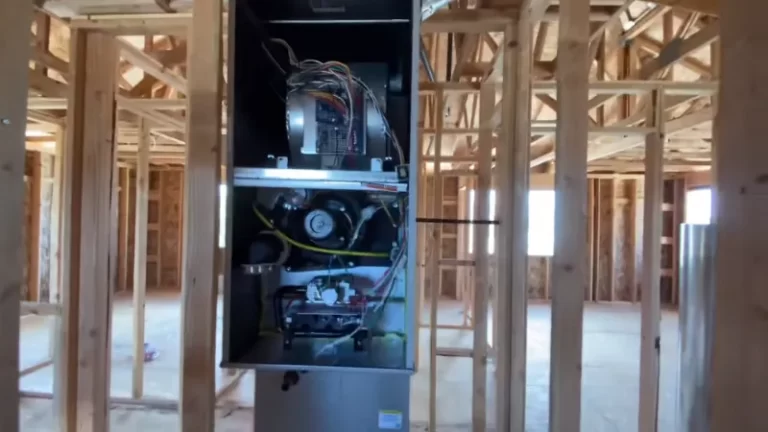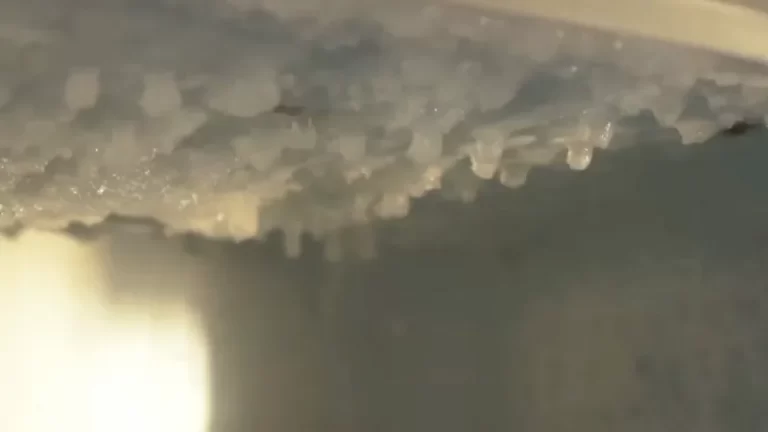GE Profile Refrigerator Temp Problems and Solutions
GE Profile refrigerators are a popular choice among consumers due to their advanced features, sleek design, and reliable performance. Proper temperature control is crucial in refrigerators as it helps to keep food fresh and prevents spoilage.
However, even the best refrigerators can experience temperature control issues from time to time. Common GE Profile refrigerator temperature control problems include the refrigerator dispenser not working, the ice maker not making ice, the temperature display not working, the refrigerator not cooling at all, the refrigerator not cooling but the freezer is fine, the freezer not freezing, the refrigerator being too cold, and the refrigerator not defrosting.
In this article, we will delve into these common problems and provide solutions and tips to keep your GE Profile refrigerator running smoothly.
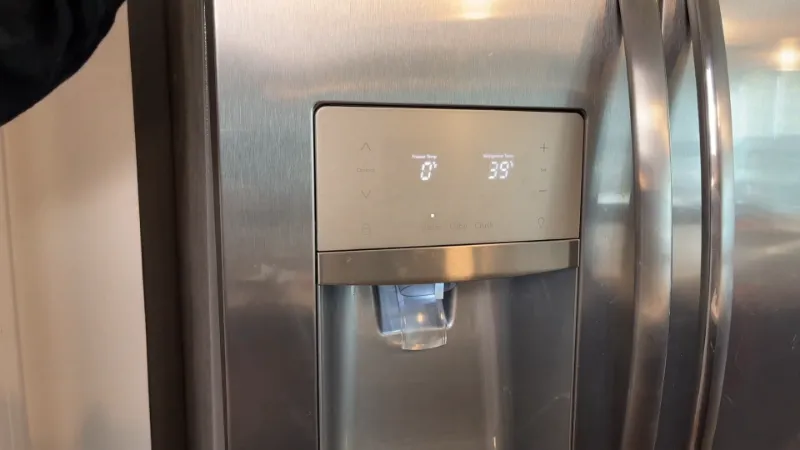
You'll Learn About
GE Profile Refrigerator Temp Problems
GE Profile refrigerators can experience temperature control problems such as a malfunctioning dispenser, slow or non-working ice maker, non-working temperature display, lack of cooling, only the freezer working, freezer not freezing, the temperature being too cold, and defrosting issues.
Some solutions include resetting the temperature through the self-diagnostic mode, replacing the temperature control board, adjusting the temperature to 37° F (2° C), and resetting the refrigerator by unplugging it for 30 seconds.
The location of the temperature controls on a GE refrigerator varies but can be found in the back of the fridge section, on the ceiling of the fridge, or at the brink of the door in French door models.
What is E5 Overcurrent Protection Error?
Problem 1: Refrigerator Dispenser Not Working
Causes of the Problem
The refrigerator dispenser is a convenient feature that allows you to access water and ice from the door. However, if it stops working, it can be a frustrating inconvenience. Some common causes of the refrigerator dispenser not working include a clogged dispenser, a malfunctioning water inlet valve, or a defective dispenser control board.
Possible Solutions
To fix the issue, you can try some of the following solutions:
Clean the Dispenser
If the dispenser is clogged, it won’t be able to dispense water or ice. Use a soft cloth and warm water to clean the dispenser and remove any buildup.
Check the Water Inlet Valve
If the water inlet valve is defective, it may not be able to dispense water or ice. You can check the valve by disconnecting the water supply and checking the valve for any leaks or damage.
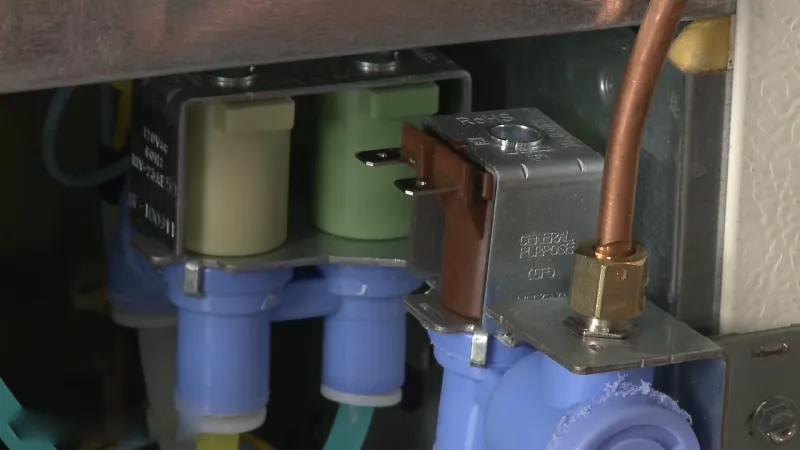
Replace the Dispenser Control Board
If the dispenser control board is defective, it may need to be replaced. You can purchase a new board from the manufacturer or a third-party supplier.
Tips to Avoid the Issue in the Future
To avoid the issue of the refrigerator dispenser not working, follow these tips:
Regular cleaning
Clean the dispenser regularly to prevent any buildup of dirt or debris that may clog the dispenser.
Check Water Quality
If you are experiencing issues with the water dispenser, it could be due to low water pressure or poor water quality. Regularly check the water supply and invest in a water filter if needed.
Proper maintenance
Regularly maintain and clean the refrigerator to keep it running smoothly and prevent any potential issues.
If your GE Profile refrigerator’s dispenser is not working, you can try a few solutions. From cleaning the dispenser to replacing the dispenser control board, the issue can be resolved with a little troubleshooting. By following the tips provided, you can prevent the issue from happening again in the future.
Problem 2: Ice Maker Won’t Make Ice or is Just Too Slow
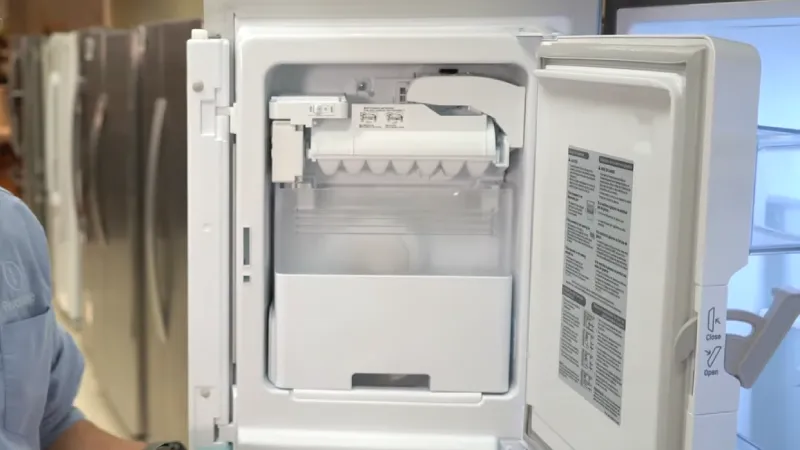
Causes of the Problem
- Low water pressure: If the water supply to the ice maker is low, it can cause the ice maker to produce fewer or no ice cubes.
- Clogged water filter: A clogged water filter can prevent water from reaching the ice maker, causing it to produce fewer or no ice cubes.
- Dirty condenser coils: Dirt and dust buildup on the condenser coils can cause the refrigerator to work harder, which can cause the ice maker to work slower or stop working altogether.
- Faulty water valve: If the water valve that supplies water to the ice maker is faulty, it can cause the ice maker to produce fewer or no ice cubes.
- Faulty ice maker: A faulty ice maker can cause it to stop producing ice altogether.
Possible Solutions
- Check the water pressure: If the water pressure is low, increase the water pressure to the recommended level.
- Replace the water filter: Replace the water filter if it’s clogged.
- Clean the condenser coils: Clean the condenser coils to remove any dirt and dust buildup.
- Replace the water valve: If the water valve is faulty, replace it with a new one.
- Replace the ice maker: If the ice maker is faulty, replace it with a new one.
Tips to Avoid the Issue in the Future
- Replace the water filter regularly: Regularly replace the water filter to ensure proper water flow to the ice maker.
- Clean the condenser coils regularly: Regularly clean the condenser coils to ensure the proper operation of the refrigerator.
- Check the water pressure regularly: Regularly check the water pressure to ensure it is at the recommended level.
If your GE Profile refrigerator’s ice maker is not working properly or is too slow, it may be caused by low water pressure, a clogged water filter, dirty condenser coils, a faulty water valve, or a faulty ice maker.
To solve the problem, check the water pressure, replace the water filter, clean the condenser coils, replace the water valve, or replace the ice maker, as needed. To avoid future issues, regularly replace the water filter, clean the condenser coils, and check the water pressure.
Samsung Refrigerator Problems and Solutions
Problem 3: Ge Profile Refrigerator Temperature Display Not Working
Causes of the Problem
The GE Profile refrigerator temperature display not working can be caused by several factors including a malfunctioning control board, loose wiring, or a damaged temperature sensor. In some cases, the problem might be a result of the control board not receiving any signal from the temperature sensor or a malfunction in the control panel itself.

Possible Solutions
To Resolve This Issue, Try the Following Steps:
- Check the control board: If the control board is not functioning properly, it might need to be replaced.
- Check the wiring: Check the wiring connecting the control board to the temperature sensor and the control panel. If there are any loose connections, tighten them.
- Check the temperature sensor: The temperature sensor is responsible for providing the control board with the temperature readings. If it is damaged or not working correctly, it will need to be replaced.
- Reset the refrigerator: Unplug the refrigerator and wait for a minute before plugging it back in. This will reset the control board and might resolve the issue.
Tips to Avoid the Issue in the Future
To prevent the temperature display from not working in the future, try the following tips:
- Regularly clean the temperature sensor to ensure it is free from dust and debris.
- Keep the control panel and control board clean and dry.
- Regularly check the wiring to ensure it is not loose or damaged.
- Call a professional technician to diagnose and resolve any issues with the control board or control panel.
Problem 4: Refrigerator Not Cooling at All
Causes of the Problem
There can be several reasons for a GE Profile refrigerator not cooling, including:
- Compressor failure: The compressor is the heart of the refrigeration system, and it may stop working if it is damaged, worn out, or overloaded.
- Evaporator fan failure: The evaporator fan is responsible for circulating air throughout the refrigerator compartment, and a failed fan can lead to warm air buildup and uneven cooling.
- Dirty Condenser Coils: The condenser coils are responsible for removing heat from the refrigerant, and they must be kept clean in order to function properly. Dirty coils can reduce the efficiency of the cooling system and cause it to stop working altogether.
- Thermostat issues: If the thermostat is not functioning correctly, it may not be able to accurately regulate the temperature within the refrigerator.
Possible Solutions
- Check the compressor: If the compressor is not running, it may need to be replaced.
- Replace the evaporator fan: If the fan is not working, it may need to be replaced.
- Clean the condenser coils: If the coils are dirty, they should be cleaned with a soft brush and vacuum.
- Replace the thermostat: If the thermostat is not functioning correctly, it may need to be replaced.
Tips to Avoid the Issue in the Future
- Regularly clean the condenser coils: This will ensure that they are able to remove heat efficiently and keep the refrigerator running smoothly.
- Avoid overloading the refrigerator: Overloading the refrigerator can put stress on the compressor and other components, leading to failure.
- Keep the airflow clear: Make sure that the air vents on the back of the refrigerator are not blocked, as this can reduce airflow and cause the unit to stop working.
if your GE Profile refrigerator is not cooling, it is important to identify the cause of the problem and take appropriate action to resolve it. By following these tips and performing regular maintenance, you can help ensure that your refrigerator continues to function properly for many years to come.
Problem 5: My Ge Profile Refrigerator Not Cooling but Freezer is Fine
Causes of the Problem
There could be several reasons why the refrigerator is not cooling, but the freezer is functioning properly. Some of the most common causes include a clogged defrost drain, a faulty defrost thermostat, damaged or clogged condenser coils, and a faulty evaporator fan motor.
Possible Solutions
To fix this issue, you can start by checking the defrost drain to ensure it’s not clogged. If it is, you can clear it using a turkey baster or a thin brush. You can also check the defrost thermostat and the evaporator fan motor to see if they’re functioning properly.
If they’re not, you may need to replace them. If the condenser coils are dirty or clogged, you can clean them using a vacuum cleaner or a brush.
Tips to Avoid the Issue in the Future
To prevent this issue from happening in the future, you can regularly clean the condenser coils and defrost the drain to ensure proper airflow. You should also ensure that the evaporator fan motor is functioning properly by checking it periodically. Finally, you can avoid overloading the refrigerator, which can make it difficult for the cooling system to work properly.
If your GE Profile refrigerator is not cooling but the freezer is functioning properly, there could be several reasons why this is happening. By checking the defrost drain, defrost thermostat, condenser coils, and evaporator fan motor, you can easily diagnose and fix the issue. By following some simple tips, you can also avoid this issue in the future.
Haier Refrigerator Problems and Solutions
Problem 6: Freezer Not Freezing
Causes of the Problem
- Improper temperature setting: If the freezer temperature is not set correctly, it may not freeze properly. Ensure the temperature setting is at the right level, typically between 0°F and 5°F.
- Dirty condenser coils: The condenser coils are responsible for removing heat from the freezer. If they are dirty, they can’t function properly, leading to the freezer not freezing.
- Faulty thermostat: A faulty thermostat can cause the freezer not to freeze. If the thermostat is not working correctly, it may not be able to sense the temperature correctly.
- Damaged evaporator fan: The evaporator fan is responsible for circulating air throughout the freezer. If the fan is damaged, it may not be able to circulate air, causing the freezer to not freeze.
Possible Solutions
- Check the temperature setting: Make sure the temperature setting is at the correct level.
- Clean the condenser coils: Clean the condenser coils if they are dirty to improve their efficiency.
- Replace the thermostat: If the thermostat is faulty, it should be replaced to correct the problem.
- Replace the evaporator fan: If it is damaged, it should be replaced to correct the problem.
Tips to Avoid the Issue in the Future
- Regularly clean the condenser coils: Keeping the condenser coils clean will help prevent the freezer from not freezing.
- Keep the freezer at the right temperature: Make sure the freezer temperature is set correctly to avoid any issues.
- Don’t overfill the freezer: Overfilling the freezer can block airflow and cause the freezer not to freeze properly.
If your GE Profile freezer is not freezing, there are several possible causes, including improper temperature setting, dirty condenser coils, a faulty thermostat, and a damaged evaporator fan.
To resolve the issue, check the temperature setting, clean the condenser coils, replace the thermostat if necessary, and replace the evaporator fan if it is damaged. By following these steps and taking preventative measures such as keeping the freezer at the right temperature and regularly cleaning the condenser coils, you can keep your GE Profile freezer running smoothly.
Problem 7: Ge Profile Refrigerator Troubleshooting Temperature Too Cold
Causes of the Problem
There are several reasons why your GE Profile refrigerator might be too cold, causing your food to freeze:
- Thermostat malfunction: A faulty thermostat can cause the refrigerator to become too cold.
- Dirty condenser coils: When the condenser coils are dirty, the refrigerator has to work harder to maintain temperature, causing it to become too cold.
- Air duct issues: If there are any issues with the air duct, it can cause the temperature inside the refrigerator to become too cold.
- Damaged evaporator fan: A damaged evaporator fan can cause the air to circulate poorly, leading to temperature imbalances and causing the refrigerator to become too cold.
Possible Solutions
Check the Thermostat
The first step is to check the thermostat. You can do this by resetting the temperature to a higher setting. If the temperature stabilizes, then the problem is with the thermostat.
Clean the condenser coils
Clean the condenser coils to ensure that they are not dirty.
Check the Air Duct
Inspect the air duct for any damage or blockages. If there is an issue, have it repaired?
Replace the evaporator fan
If the evaporator fan is damaged, it needs to be replaced.
Tips to Avoid the Issue in the Future
Regular maintenance
Regular cleaning and maintenance of the condenser coils, air duct, and evaporator fan can help avoid this issue in the future.
Keep the Door Seals Tight
Make sure that the door seals are tight and in good condition. This will help prevent air from entering the refrigerator and causing temperature imbalances.
Adjust the temperature setting
Regularly check and adjust the temperature setting as needed.
By following these tips and troubleshooting solutions, you can solve the problem of your GE Profile refrigerator becoming too cold and freezing your food.
Problem 8: Ge Refrigerator Not Defrosting
Causes of the Problem
- Clogged Defrost Drain: The defrost drain can become clogged with ice, preventing water from draining properly.
- Defrost Thermostat Failure: If the defrost thermostat fails, it can prevent the defrost cycle from starting and melting any accumulated frost.
- Defrost Heater Failure: The defrost heater is responsible for melting any frost accumulation in the freezer. If it fails, the defrost cycle will not take place, and frost will continue to accumulate.
- Evaporator Fan Failure: The evaporator fan is responsible for circulating air throughout the freezer. If it fails, it can cause frost accumulation and prevent the defrost cycle from taking place.
Possible Solutions
- Clogged Defrost Drain: You can clear the clogged drain by using a turkey baster or a small hose to suck out any clogs.
- Defrost Thermostat Failure: The defrost thermostat can be replaced if it fails.
- Defrost Heater Failure: If the defrost heater fails, it will need to be replaced.
- Evaporator Fan Failure: The evaporator fan can be replaced if it fails.
Tips to Avoid the Issue in the Future
- Clean the defrost drain regularly to prevent clogs.
- Regularly check the defrost cycle to ensure it’s functioning properly.
- If you notice frost accumulation in the freezer, investigate the cause and take corrective action to prevent future collection.
- Regularly clean and maintain the evaporator fan to ensure proper functioning.
GE Profile Refrigerator Temperature Control Problems and Solutions
Incorrect Temperature Settings
Incorrect temperature settings are a common problem in GE Profile refrigerators. If the temperature inside your refrigerator is not what you set it to, the food inside may spoil, or the unit may not be energy efficient. The incorrect temperature can cause the freezer to defrost, or it may not be cold enough to keep the food fresh.
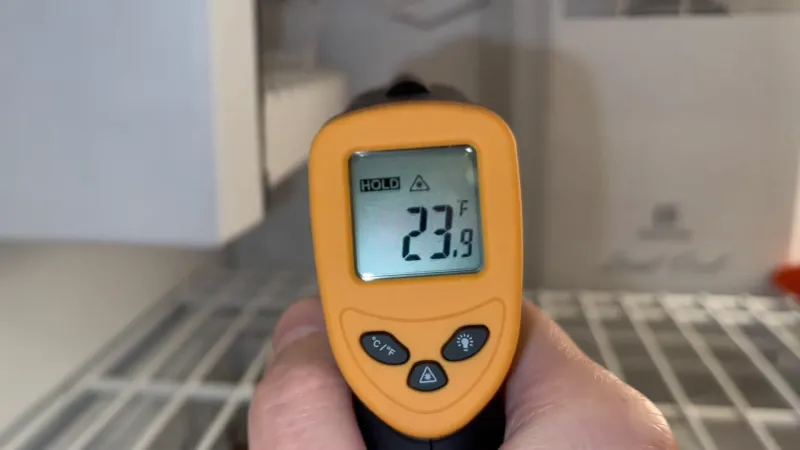
Causes of Incorrect Temperature Settings
There are several reasons why your GE Profile refrigerator may have incorrect temperature settings. Some common causes include a malfunctioning thermostat, a damaged temperature control board, a clogged condenser, or a problem with the compressor. Sometimes, incorrect temperature settings are also caused by a lack of proper ventilation, which can prevent the unit from maintaining the desired temperature.
How to Fix the Problem
Fixing incorrect temperature settings in a GE Profile refrigerator can be simple or complex, depending on the cause. Here are some steps you can take to resolve the problem:
Check the Thermostat
If the thermostat is damaged, it may not be able to accurately measure the temperature inside the refrigerator. You may need to replace the thermostat to resolve this problem.
Inspect the Temperature Control Board
If the temperature control board is damaged or malfunctioning, it may not be able to control the temperature of the unit. Replacing the temperature control board should resolve this problem.
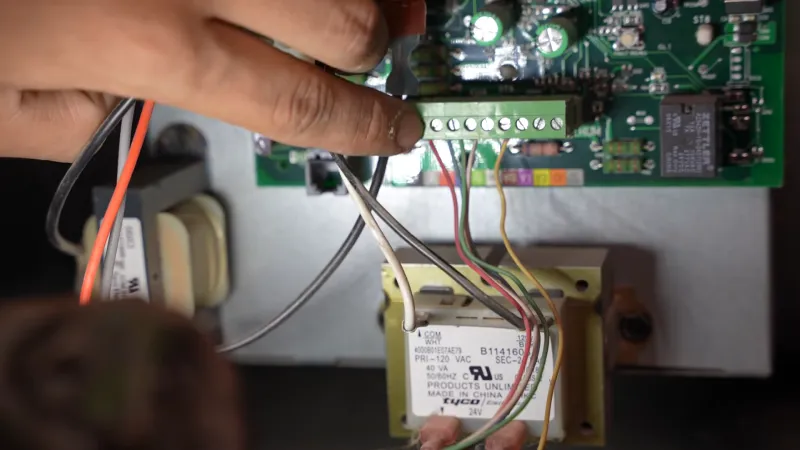
Clean the Condenser
A clogged condenser can prevent the refrigerator from cooling properly. Cleaning the condenser should resolve this problem.
Check the Compressor
If the compressor is damaged, it may not be able to cool the unit properly. Replacing the compressor may be necessary to resolve this problem.
Ensure Proper Ventilation
Make sure there is enough space around the refrigerator for proper ventilation. This can help prevent incorrect temperature settings caused by a lack of proper ventilation.
incorrect temperature settings in a GE Profile refrigerator can be caused by various issues. If you’re having trouble with the temperature control, try the above solutions to resolve the problem. If the issue persists, it’s best to seek professional help to avoid further damage to the unit.
Opened Freezer Door
A common problem with GE Profile refrigerators is the temperature display being blank. This can occur if the freezer door has been left open for an extended period of time. When the door is open, warm air enters the freezer, causing the temperature to rise and the cooling system to work harder to maintain the desired temperature.
This can cause the temperature display to shut off.
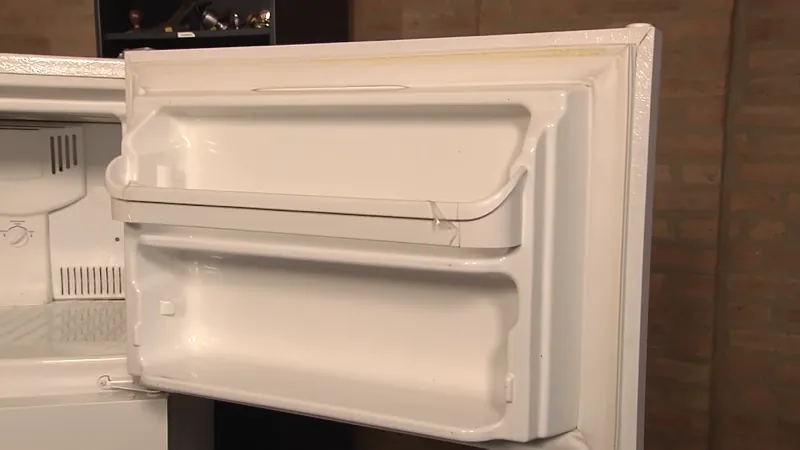
Causes of an Open Freezer Door
The most common cause of an open freezer door is simply forgetting to close it properly. It can also be caused by a faulty door gasket, which allows warm air to enter the freezer even when the door is shut. A malfunctioning door switch, which is responsible for telling the refrigeration system when the door is open or closed, can also be a cause of an open door problem.
How to Fix the Problem
If the display is blank, check to make sure the freezer door is closed correctly. If it was left open, simply close it and wait for the temperature display to return. If the door is closing correctly but the display still won’t turn on, check the door gasket for damage or replace it if necessary.
If the door switch is malfunctioning, it will need to be replaced. If the problem persists, it may be a more serious issue with the refrigeration system and a professional repairman should be consulted.
GE Profile Refrigerator Temperature Problems and Solution
Malfunctioning Temperature Control Board or Thermostat
A malfunctioning temperature control board or thermostat can cause temperature control problems in GE Profile refrigerators. The temperature control board is responsible for managing the cooling system, while the thermostat monitors the temperature inside the refrigerator and communicates with the control board to ensure the desired temperature is maintained. If either of these components malfunctions, the refrigerator may not be able to maintain the correct temperature.
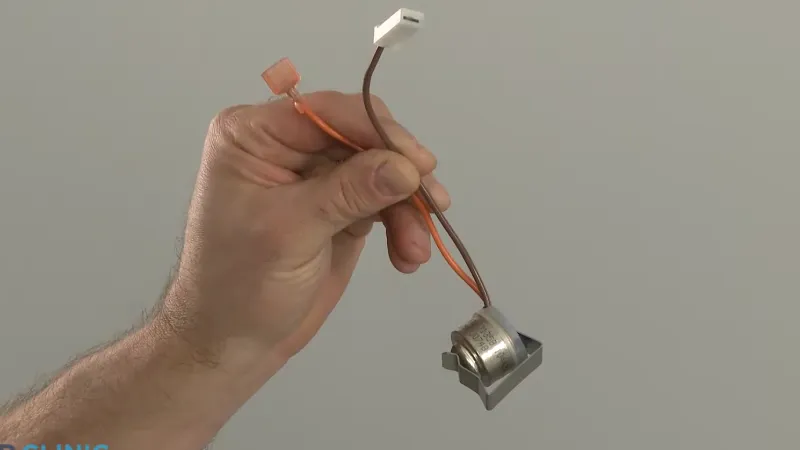
Causes of a Malfunctioning Temperature Control Board or Thermostat
There are several reasons why the temperature control board or thermostat may malfunction. A power surge or lightning strike can damage the board, while a faulty wiring connection or a bad temperature sensor can cause problems with the thermostat. In some cases, the control board or thermostat may simply wear out over time and need to be replaced.
How to Fix the Problem
To diagnose the problem, it is important to first unplug the refrigerator and check the wiring connections. If they appear to be in good condition, the control board or thermostat should be replaced. This is a relatively straightforward process for a competent do-it-yourselfer, but if you are unsure of your ability to complete the repair, it is best to consult a professional.
it is important to take proper care of your GE Profile refrigerator to avoid temperature control problems. If you are experiencing issues with temperature control, checking the settings, door gasket, door switch, temperature control board, or thermostat can help diagnose the problem and get your refrigerator back to functioning properly.
Internal Cooling Issues
A GE Profile refrigerator that is not cooling properly can be a frustrating issue. If the temperature inside the refrigerator is warm, it can cause food to spoil and create an unpleasant odor.
This can be a sign of an internal cooling issue, which may have a few different causes.
GE Refrigerator Temperature Control Problems and Solutions
Causes of Internal Cooling Issues
There are several factors that can contribute to internal cooling issues in a GE Profile refrigerator. One common cause is a clogged or dirty condenser coil, which can prevent the refrigerator from efficiently releasing heat.
Another cause could be a malfunctioning fan, which circulates air within the refrigerator and helps maintain a stable temperature. A faulty compressor can also lead to internal cooling issues, as the compressor is responsible for pumping refrigerant and facilitating heat transfer.
How to Fix the Problem
To resolve internal cooling issues, you should first unplug the refrigerator and clean the condenser coils. If this does not resolve the issue, you can check the fan to see if it is functioning correctly.
If the fan is working, you may need to have the compressor inspected by a professional. If the compressor is faulty, it will need to be replaced. If you are not comfortable working with refrigerators, it is best to consult with a professional to diagnose and resolve the problem.
Recommended Temperature for Ge Profile Refrigerators
The recommended temperature for a GE Profile refrigerator is between 37-42°F (3-5°C) for the fridge and 2-8°F (-16 to -13°C) for the freezer. This temperature range ensures that the food stored in the fridge stays fresh and that the freezer keeps the food frozen. It is important to set the temperature correctly to avoid spoilage or damage to the food.
Factors Affecting the Recommended Temperature
The recommended temperature can be affected by various factors such as the ambient temperature, the number of times the door is opened, the placement of the fridge, and the load on the fridge. If the ambient temperature is high, the fridge may have to work harder to maintain the temperature, and this can cause the temperature to fluctuate.
How to Set the Temperature Correctly
To set the temperature correctly, locate the temperature control panel on your GE Profile refrigerator. This may be located in the back of the fridge section or on the ceiling of the fridge. Adjust the temperature to the recommended range, and give the fridge 24 hours to stabilize.
If the lights are still flashing after 24 hours, reset the fridge by unplugging it for 30 seconds.
The recommended temperature for a GE Profile refrigerator is an important factor in ensuring that the food stored in the fridge stays fresh and that the freezer keeps the food frozen. To ensure that the temperature is set correctly, it is important to take into account the ambient temperature and other factors that may affect the temperature and to adjust the temperature as necessary.
French Door Refrigerator Problems and Solutions
Conclusion
GE Profile refrigerators are popular and well-regarded appliances that provide efficient temperature control to keep your food fresh and safe. However, like any appliance, GE Profile refrigerators can encounter a range of temperature control problems.
From dispenser issues, slow ice makers, display problems, improper cooling, and freezer issues, to temperature being too cold or not defrosting, these problems can be frustrating and sometimes even spoil your food.
By understanding the causes, possible solutions, and tips for avoiding these problems, you can take proactive steps to keep your GE Profile refrigerator running smoothly. Regular maintenance and proper usage can help prevent these issues and ensure that your refrigerator provides efficient temperature control for years to come.

